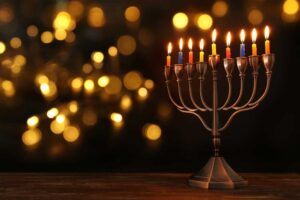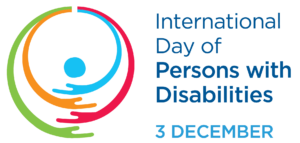The Most Wonderful Time of The Year
Few months present as many multicultural celebrations as December, including Chanukah (Hanukkah), Christmas and Kwanzaa. These expressions of culture and religious traditions are all associated with “light,” a common holiday symbol representing hope for peace and understanding. The Department of Medicine would like to wish a happy holiday to all.
November 28 – December 6 — The Festival of Lights: Chanukah (Hanukkah)
Hanukkah 2021 began the evening of Sunday, November 28, and ends the evening of Monday, December 6, nearly three full weeks before Christmas. The eight-day Jewish celebration commemorates the rededication during the second century B.C. of the Second Temple in Jerusalem, celebrated with a nightly menorah lighting.
The exact date of Hanukkah always fluctuates from year to year due to discrepancies between the Hebrew and the Gregorian calendars. The latter calendar year is based on the 365 days it takes the earth to orbit the sun, while the Hebrew calendar year is based on the 354 days it takes for the moon to go through 12 complete cycles of roughly 29.5 days each.
 Over time, the Jewish calendar falls more and more out of phase with the solar one, and if left that way the holidays would gradually migrate across the entirety of the solar year. To ensure this doesn’t happen, the two calendars are brought back into sync every so often by the addition of an additional month to the Jewish year. Not surprisingly, the calendars are most out of sync just prior to a Jewish leap year.
Over time, the Jewish calendar falls more and more out of phase with the solar one, and if left that way the holidays would gradually migrate across the entirety of the solar year. To ensure this doesn’t happen, the two calendars are brought back into sync every so often by the addition of an additional month to the Jewish year. Not surprisingly, the calendars are most out of sync just prior to a Jewish leap year.
The current Jewish year of 5782 is just such a year. That’s why Rosh Hashanah was also unusually early this year, beginning on Sep. 6. In the early spring, the Jewish calendar will add an additional month, Adar II, to bring the calendars back into alignment. That will ensure that Passover 2022 falls out at a more typical date: April 15.
Did you know? The story of Hanukkah does not appear in the Torah because the events that inspired the holiday occurred after it was written and there are different interpretations including the story of the Hanukkah Miracle. It is, however, mentioned in the New Testament, in which Jesus attends a “Feast of Dedication.”
In an allusion to the miracle, traditional Hanukkah foods are fried in oil. Potato pancakes (known as latkes) and jam-filled donuts (sufganiyot) are particularly popular in many Jewish households. Other Hanukkah customs include playing with four-sided spinning tops called dreidels and exchanging gifts. Learn more.
December 25 — Christmas
 Christmas is a Christian holiday that celebrates the birth of the baby Jesus almost 2,000 years ago. Over the centuries, the celebration of Christmas has incorporated songs and customs from many regions of the world, including the Christmas tree, originally a pagan symbol from northern Europe. Learn more.
Christmas is a Christian holiday that celebrates the birth of the baby Jesus almost 2,000 years ago. Over the centuries, the celebration of Christmas has incorporated songs and customs from many regions of the world, including the Christmas tree, originally a pagan symbol from northern Europe. Learn more.
December 26 – January 1 — Kwanzaa
Kwanzaa is a relatively new holiday, dating back to the 1960s. It is an African American celebration of African culture and roots. Kwanzaa is celebrated for seven days, and each day is dedicated to a different human value. On each day of Kwanzaa, a candle is lit in a kinara, or candleholder, to highlight one of these basic principles. Maulana Karenga described it as a time to “discover and bring forth the best of our culture, both ancient and current, and use it as a foundation to bring into being models of human excellence and possibilities to enrich and expand our lives. Discover seven interesting facts about Kwanzaa, and visit the National Museum of African American History and Culture to learn more.
Disability Awareness
 December 3 is the “International Day of Persons with Disabilities,” a day of observance for people who live with some form of disability, proclaimed by the United Nations in 1992. All people should be valued for their unique talents and abilities.
December 3 is the “International Day of Persons with Disabilities,” a day of observance for people who live with some form of disability, proclaimed by the United Nations in 1992. All people should be valued for their unique talents and abilities.
The World Health Organization estimates there are over 1 billion people — about 15% of the global population — who experience some form of disability, and this number is increasing. Almost everyone will be permanently or temporarily impaired at some point in their life.
People with disabilities represent a diverse group with a wide range of needs, and some of these are not easy to see. Disparities abound in this population, from access to health care to education and employment. Many people with disabilities also have underlying health needs that make them particularly vulnerable to COVID-19. Unfortunately, people with disabilities are often left out of the ‘diversity and inclusion’ conversation. Watch the following videos to learn more.
Things People With Disabilities Wish You Knew
This BuzzFeed video features people with disabilities such as Cerebral Palsy, Tourette syndrome and Lupus, sharing their perspectives on human interactions.
Go Forth and Be Human: Disability Sensitivity Training
This is a disability training video sponsored by the District of Columbia Office of Disability Rights. VisitOdr.dc.gov to learn more.
Disability and Work: Let’s Stop Wasting Talent
Disability is still a barrier to employment for millions of people – but it doesn’t have to be this way. Drawing on her own experience in the medical profession, Hannah Barham-Brown argues that people with disabilities are an asset more employers need to harness. Hannah Barham-Brown is a doctor, disability advocate and member of the British Medical Association Council. In 2018, she was named one of the UK’s 100 most influential disabled people on the Shaw Trust’s Disability Power 100 List for her work in medicine, politics and the media.